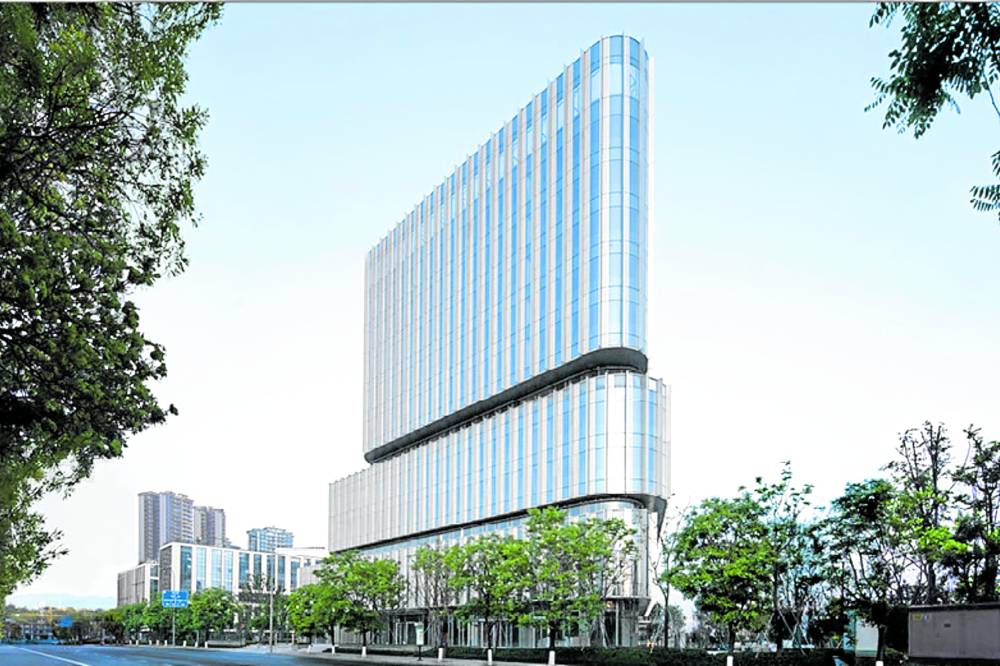
‘GREEN’ BUILDING 10 Design completes Haisco Plaza, a community center in Chengdu, China. —Contributed photo
Just because an edifice is meant to be an office building does not make it all right to simply build it like boxes stacked one on top of the other.
Functional and serviceable need not be drab, Spartan and totally without distinction.
“Architecture is a way of adding value to a property,” says Jose Claudio Silva, design principal of 10 Design, an international architecture and masterplanning firm that is part of the Egis Group, a global leader in the consulting, construction, engineering and mobility service sectors.
Perhaps it may also be said that good architectural design is a way of giving value to the people who have to work in that building or transact business with the offices it hosts.
Hong Kong-based 10 Design is introducing to the Philippines its multinational, multicultural way of doing things that is anchored on a deep knowledge of the tradition and history of the country where it is building while harnessing 21st century design tools and realities, including the need for sustainability and to address new requirements revealed by the recent COVID-19 pandemic.
Silva, a Portuguese, and American Barry Shapiro, managing principal for Asia, were in the Philippines recently to give businesses and property developers a peek into the kind of work 10 Design does.
10 Design has expertise in 11 sectors, including transport-oriented developments, as well as mixed-use, retail, hospitality, residential, research and science, and civic and cultural projects.
“Our approach to architecture is a way to add value for clients,” Silva says. The firm looks for “unique ways” to develop the value of the investment, regardless of what it is going to be—a residence or a business office.
Changing expectations
According to Silva, as Filipinos broaden their horizons through travel, particularly with the large number of overseas Filipinos dispersed almost in every part of the globe, their attitudes are changing and they have developed certain expectations about how a building looks as well as the facilities, services and amenities it should be able to provide.
“They expect not just efficiency but a pleasant experience inside a building,” he says.
While the Philippines has several architectural design groups, Silva believes there is room for a company as eclectic as 10 Design, but which “understands Asian culture” quite well.
“We bring an international perspective to a project” and “bring ideas from other parts of the world,” he says.
And while the Hong Kong office is a mini-United Nations with a staff of 38 different nationalities—a melting pot of cultures—10 Design still finds it prudent to partner with a local to design projects “that are very much specific to each country,” Silva says.
10 Design views the culture of a country through an international perspective and uses valuable lessons from local building traditions in construction that meets 21st century needs and addresses emerging and potential requirements.
It captures the essence of traditional architecture and makes it contemporary. “We take into account the local culture” and works to have “a greater understanding of the heritage” of the host community.
Sustainable
The 10 Design process, Silva says, is collaborative. The firm encourages multiple ideas from which to draw the final blueprint. “We always look at diverse factors that go into a design—people, situations—and find a sustainable approach to the problem.”
Sustainability, the idea of preserving and conserving resources for future generation, is increasingly being demanded by clients, he points out. While some may demur at the extra cost now, they eventually see how the investment will pay off in the long term.
Technology has significantly altered the traditional way of doing things and COVID-19 has dramatically reshaped—or, more accurately, hastened changes in the workplace and the way people perform their jobs.
“Even before COVID, some companies were already thinking of changing work environments,” Silva notes.
Expectations from both employees and clients have increased and changed. They now want and need business and commercial establishments to be more than just walls and roofs providing for their basic requirements.